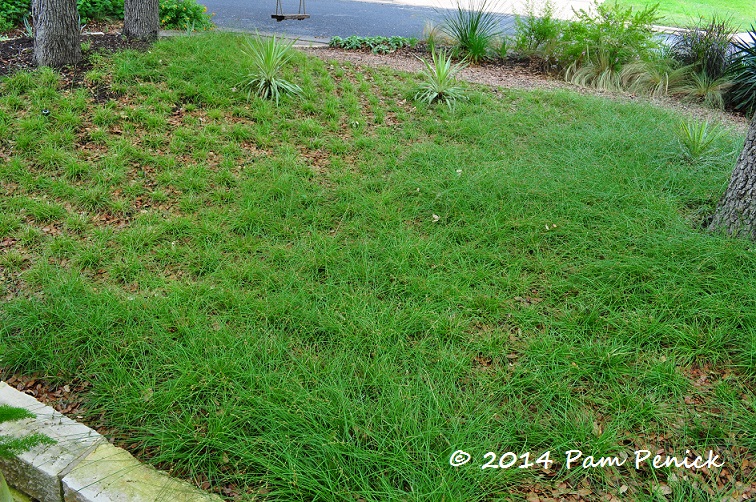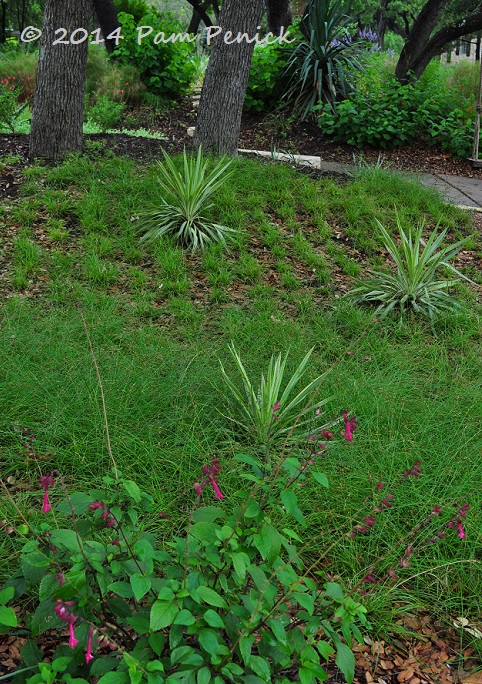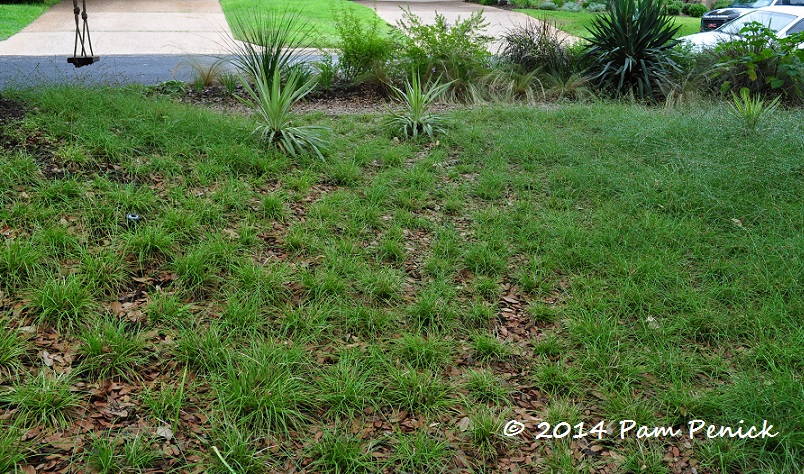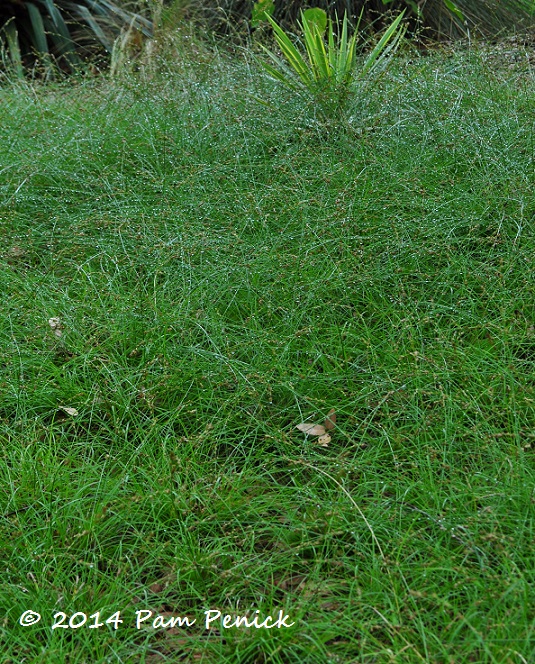Sedge lawn update, 1 year later
It’s time for an update and assessment on the Berkeley sedge (Carex divulsa) “lawn” I installed in my front garden a year ago, in March 2013. (Click the link for my how-to.) Seven months after planting I posted an update, noting that certain areas had filled in well but one section still resembled new hair plugs.
As you can see, the sedge lawn is still patchy, with lush growth on the right and persistent gaps between the plugs on the left. I’ve evaluated my sprinkler system coverage several times and can’t see any problems there, and I prepared all the soil the same way, so I’m not sure what the problem is. Last fall I spread a light layer of compost and mulch between the thin sedges, hoping to encourage them, and that did seem to help. I also fertilized again this spring with organic Medina Hasta-Gro Lawn, and that helped significantly.
It’s a little more evident in this photo that the ground undulates; it’s essentially a shallow trough, lowest in the middle and sloping on each end of the lawn, where the live oaks are growing. The sedge is growing well on one of the slopes and in the low middle.
It’s only on the other slope that it’s struggling — if struggling is even the right word. It looks healthy. It’s just not growing very much. However, it IS growing, and I’m prepared to wait it out.
Overall, I am really enjoying the shaggy, touchable texture of the sedge lawn and, best of all, the fact that it requires very little maintenance. I mow twice a year on a high setting: once in early summer, after it goes to seed, and once in early fall. I water on my city-mandated irrigation day (once a week only), just like the rest of my garden. I fertilize with an organic drench via a hand sprayer connected to the hose twice a year, spring and fall. No weekly mowing or additional watering. No edging. No creek-poisoning lawn chemicals.
What do you think? Is sedge something you’d try in a shady area where your lawn is not thriving or needed?
All material © 2006-2014 by Pam Penick for Digging. Unauthorized reproduction prohibited.






Here in Massachusetts we do have to mow, although my husband and I confess that that happens less and less over the course of the summer. No real turf. You could either call it a ‘typical weedy patch’ or, my preference, a flowery mead. Lots of ‘wildflowerss’ in the spring and fall. No poisons. No fertilizers. No watering. It is cool enough in our higher elevations that it doesn’t even turn brown during the summer drought.
I love the idea of a low-maintenance “flowery mead” — a lot more natural and wildlife friendly than a conventionally maintained monoculture of pampered turf grass. —Pam
It’s interesting to see how the sedge is growing so differently on one side.
I tried Berkeley sedge in one area under oak trees along the front walk but gave up and moved it to the side yard last fall since it was in such a prominent spot. I installed Texas sedge along my stone pathway in the side yard this spring and added Webberville sedge to the mix after finding it just a few weeks ago. I don’t mind waiting on the sedge since just having something planted there is an improvement!
I have heard good things about Webberville sedge for our area, Shirley, but haven’t tried it myself. I am growing Texas sedge in my back garden, and it has filled in very quickly. I’m wondering whether the slowness of the Berkeley sedge is due to the species or something specific to that spot. I’ve seen it growing beautifully in other gardens around town, so I’m inclined to think it’s something specific to that part of my yard. —Pam
Checked this morning and the Webberville sedge is putting out new growth after only two weeks while the Texas sedge looks pretty much the same after about six weeks.
Your sedge lawn inspired me to round up my Mexican feather grass volunteers and use them to fill a side area which was once a lawn. I had planted blue fescue plants from a nursery flat, but it is growing slowly and the bunnies seem to like to nibble at it. They leave the feather grass alone.
Feathergrass is so versatile, thriving in sun and growing well even in part shade. A neighbor of mine has a beautiful swath under some high-limbed trees. They simply glow in the afternoon sunlight. —Pam
Is it possible that you have two different varieties of sedge? I wonder what would happen if you transplanted some of the larger sedge into the area that is not growing as much. It looks like there are more trees on the side that is not growing as well and maybe more competition for moisture.
I am fairly certain I have all the same sedge because I bought from a sedge expert. It did occur to me to wonder if the trees at left are sucking up more water. There are just as many trees on the right (out of camera frame), but maybe they’re not as thirsty? Who knows! —Pam
Patience Weedhopper.
Ohmmmm. —Pam
The difference in sedge growth rate is indeed a mystery. I had an experienced gardener once tell me that whenever there was a spot where things just did not fare well year in and year out it was a good bet that was where the original construction site’s trash heap had been placed. She said things get deposited and/or leached out deep under the soil during construction that can affect fertility and growth rates for a long, long time.
I can’t say that is what your area has going on, but for whatever reason that explanation for a bit of a “flail zone” I have here helps me fret less.
And PS – my sedge is in significant shade and is growing v e r y, v e r y slowly. Yours looks riotously lush by comparison! On either side.
“Flail zone” — too funny! I’ll try to imagine my little sedges working hard to clean up impure soil. Go, sedge, go! —Pam
I like the look of both of the plantings. I bet in 2-4 years it will all be the same! Here is a thought : wonder if the fallen leaves from the live oak cause diminished growth due to tannic acid from the leaves? I heard about this happening from a speaker at the Natural Gardener a few weekends ago.
I think the mystery will just continue to be a mystery, Shelley. The oaks on the other, lusher side are just as prolific, but the sedges are happier there. I guess this is nature’s way of keeping me guessing. 🙂 —Pam
a microclimate with a little more sun on the slow side?
I like to plant Dusty Miller as an informal hedge. The cuttings are harvested from flourishing plants in my garden – and the hedge always has one or two that won’t play nicely with the others!
WOW! It looks great, Pam. What an awesome change. Can’t wait to see how the sedge lawn looks in the winter. Say, on a related note – to me, garden mysteries are like Catholic mysteries.
Cheers,
A rather Catholic gardener
Pam, dear,
What about seeds? Is it possible to get Berkley to grow from seed?
I imagine so, Michele, as McNeal Growers recommends letting existing plants go to seed before mowing them, in order to help thicken up the planting. I don’t know of anyone selling seeds locally. Maybe a Google search will reveal something. I will say that my Berkeley sedge has grown so slowly that I can’t imagine trying it from seed. But I’m not the most patient person in the world. 😉 —Pam